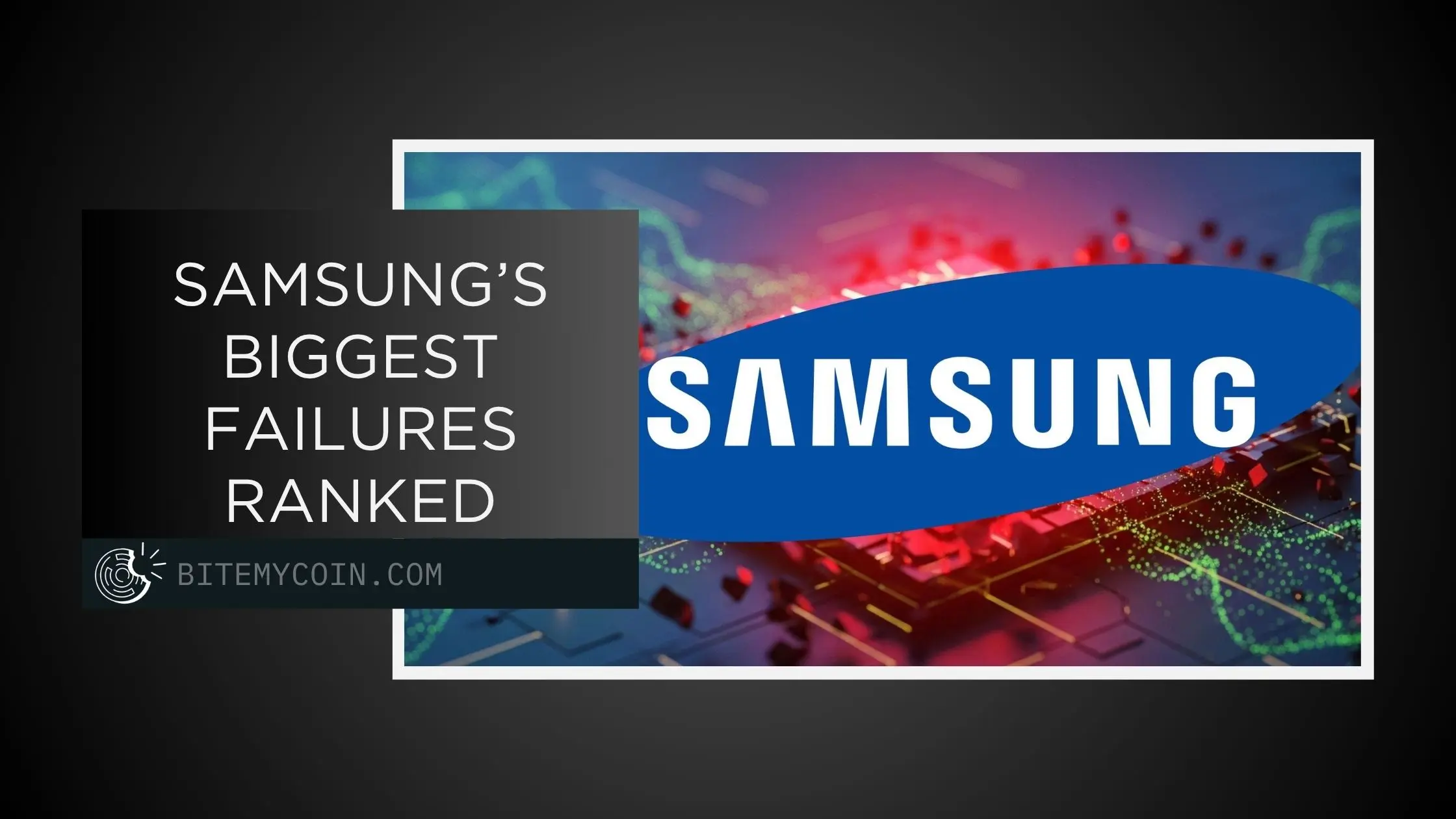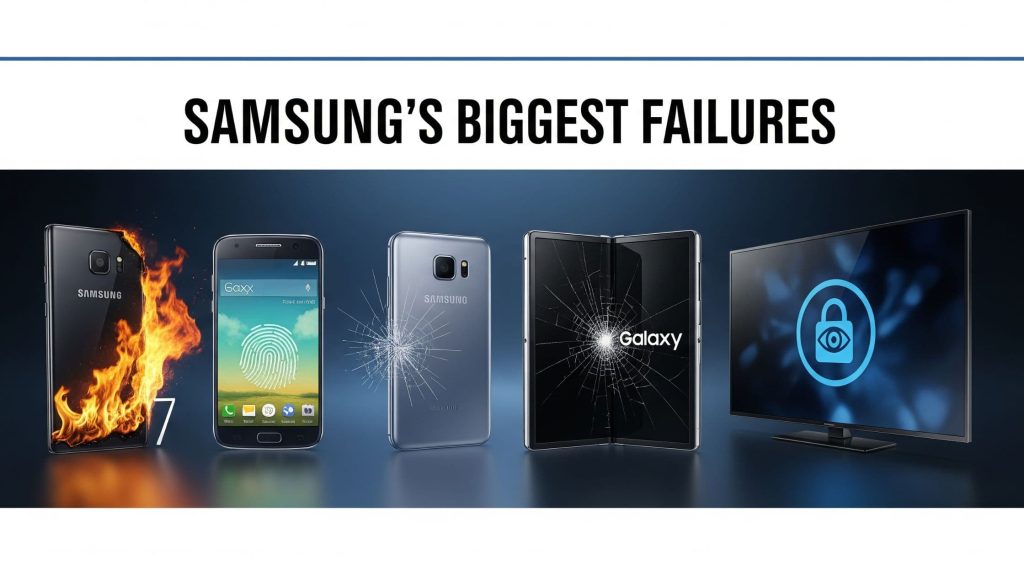Samsung’s Biggest Failures Ranked: From Galaxy Note 7 to Smart TV Privacy Concerns

Samsung is one of the biggest names in the technology industry, offering a wide range of products from smartphones to dishwashers, and everything in between. The South Korean electronics giant has been at the forefront of innovation, sometimes pushing boundaries to revolutionize the way consumers interact with technology.
But for every success story, there have been some colossal failures that straight-up tainted the company’s brand. In this blog, we rank some of the biggest tech failures from Samsung, offering a glimpse into how even the most successful multinational companies can sometimes make costly mistakes.
Ranking Failed Samsung Products

1. Galaxy Note 7
The seventh generation of Samsung’s Galaxy Note series is by far the most notable failed tech product in history. Launched in August 2016, the high-end smartphone was well-received, and sported a 5.7-inch Super AMOLED screen, a 12MP rear camera with dual-pixel technology and optical image stabilization (OIS), and a 5MP selfie camera.
The device was powered by Samsung’s Exynos 8890 octa-core processor with 4GB of RAM and 64GB of internal storage, which could be expanded to up to 256GB via microSD. It came with an IPX8 water-resistant rating and a 3,600mAh battery. Despite all the bells and whistles of a great smartphone, the Galaxy Note 7 was a ticking time bomb that was even banned from airplanes.
The smartphone’s failure was primarily attributed to defects in its lithium-ion batteries, which caused some units to overheat, catch fire, and in some cases, explode. This led to Samsung issuing a global recall a month after launch, but the situation worsened when replacement devices also experienced similar issues. Samsung had to ultimately pull the plug on the Galaxy Note 7, recalling over 2.5 million units that cost the company an estimated $5.3 billion in losses.
An internal investigation discovered design and manufacturing flaws in the battery, which was produced and supplied by two different manufacturers. The first batch of batteries had a design issue where their positive and negative tabs were breaking down, resulting in a short circuit, and the second batch had a welding defect that led to the battery catching fire. Note 7’s design was also partially responsible for the issue, with the battery being too tightly packed within its frame, leaving no room for thermal expansion. This lack of space caused the batteries to compress and potentially combust during heavy use.
Samsung issued a public apology, acknowledging its failure to identify the issues before launching the smartphone. In response, the company implemented stricter quality control measures and a new eight-step quality control program to prevent similar events in the future. A refurbished version of the Galaxy Note 7 was released in 2017 called the Galaxy Note Fan Edition.
2. Galaxy S5
The Galaxy S5 was Samsung’s flagship smartphone from 2014. The device was praised for its 5.1-inch AMOLED display, 16MP camera, Snapdragon 801 chipset, and the long battery life provided by the 2,800mAh cell. It was the last Samsung smartphone to feature an IR blaster, infrared port, USB 3.0, and a plastic back plate with a removable battery.
However, the phone was severely criticized for its bloatware, unresponsive fingerprint scanner, and the use of “cheap” polycarbonate instead of metal or glass. Users experienced problems such as overheating and battery drain, frequent alerts even when they were turned off, the screen not turning on automatically during standby, audio issues during calls, and camera failures. Despite being water-resistant, the phone was prone to water damage.
While most of these issues could be easily cleared, the Galaxy S5’s fingerprint sensor was a thorn in the heel. Users reported the sensor sometimes failing to load and displaying error messages, asking them to reboot the phone. Another issue was that the sensor failed to recognize fingerprints when trying to unlock the phone while it was charging. The sensor could also be easily tricked by placing the image of the user’s fingerprints to unlock.
Samsung offered quick solutions to the troubles by updating the Galaxy S5’s software and security systems, and issuing recalls to repair hardware such as the battery and screen. The company also warned users not to submerge the device and to check for signs of water damage, such as a red indicator under the battery.
3. The Galaxy Fold
Released in September 2019, the Samsung Galaxy Fold was the first foldable smartphone from Samsung, and needless to say, it was a giant leap by the company. However, it encountered significant reliability and durability issues.
Initial reviews showed that the foldable screen on the inside was prone to damage, with some units experiencing screen flickering, blackouts, or developing bumps and bulges. Samsung had applied a protective layer on the screen, which some users mistakenly removed, resulting in damage. The issue was attributed to the Fold’s hinge mechanism and the durability of the ultra-thin glass layer on the display, which were not robust enough to handle repeated folding and unfolding.
In response to these issues, Samsung delayed the release of the Galaxy Fold and made several design improvements, such as enhancing the hinge and adding a protective layer to the display to increase its durability. The company also provided a detailed instruction manual in the box, advising users not to remove the protective layer, avoid exposing the device to liquids and small particles that could get stuck between the inner display, and refrain from pressing the screen with hard objects.
Samsung learnt from its mistakes and turned the Galaxy Fold series into one of the most desirable and sought-after smartphones in the market. The device also laid the foundation for further innovations in the niche, with other manufacturers like Google, Motorola, Oppo, and OnePlus coming out with their own iterations of foldable smartphones.
Also Read: Apple’s Most Hated Product of 2025
4. Smart TV Privacy Concerns
In 2015, Samsung faced a major crisis after it released an unfortunately worded statement about its smart televisions monitoring living room conversations. This led to the public growing concerned about their privacy.
The Samsung SmartTV offered features aimed at enhancing video content, including personalized recommendations, connecting to users’ social media accounts, and the ability to interact and control the TV using gestures and voice commands. As per Samsung’s privacy policy, it collects, uses, shares, and stores user information collected through the SmartTV.
The main concern for users was the Automatic Content Recognition (ACR) technology used by Samsung, which tracked what users watched on their TVs. This data is then used to provide personalized recommendations and advertisements. Voice recognition was also an area of concern, as Samsung transmitted some interactive voice commands to third-party service providers for conversion to text.
The SmartTVs also had facial recognition technology, allowing users to authenticate their Samsung Account with their face. The company collected this information for analysis and to improve its services.
All these were huge privacy concerns, as users were unaware that their conversations were recorded by the company and shared with its partners. Samsung had to do immediate damage control and revise its policy to ensure that users’ data is better protected.
5. Galaxy Beam
The Samsung Galaxy Beam was a unique smartphone that featured an integrated pico projector, allowing users to project content from their phone onto any hard surface. While the Beam stood out from other smartphones in the market at the time, it faced some serious issues.
One of the main complaints was the weak software support for the projection feature, which could not fully utilize the device’s potential. Additionally, the projector only functioned properly in dark environments on light-colored surfaces. The Beam was also noticeably thicker and heavier than typical smartphones due to housing a larger battery, which was also not efficient, as the device did not last very long during regular use.
All these factors resulted in poor sales for the Samsung Galaxy Beam, and it ended up being a one-off project that never came back.
Final Thoughts
Despite the minor but costly setbacks, Samsung continues to revolutionize the tech industry with its products and services. Without the Galaxy lineup, the Android ecosystem may have never taken off or competed shoulder to shoulder with Apple’s iOS.
Samsung is among the largest producers of consumer electronics and smartphones, and is one of the most innovative companies in the world. Its failures are a testament to the tremendous success it has achieved since 2010.
Tech & Gaming Expert